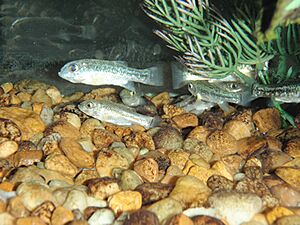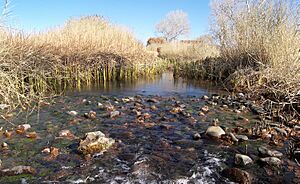Comanche Springs pupfish facts for kids
Quick facts for kids Comanche Springs pupfish |
|
|---|---|
 |
|
| Conservation status | |
| Scientific classification |
The Comanche Springs pupfish (Cyprinodon elegans) is a small, unique fish. It belongs to a group of fish called pupfish. This special fish lives only in Texas, in spring-fed pools near Balmorhea. Balmorhea is a small town in West Texas.
Contents
About Its Name
Scientists first found and described the Comanche Springs pupfish in 1853. The fish got its name from the Comanche Springs. These springs were once a big water source in Pecos County, Texas. Sadly, these springs dried up in 1955.
What It Looks Like
The Comanche Springs pupfish is a small fish, about 50 mm (2 inches) long. Male pupfish have a cool speckled pattern on their bodies. They also have a smooth, streamlined body shape. Unlike some other pupfish, they do not have vertical stripes. Their back is quite flat.
Fish from different places might have small differences. These can include the number of fin rays. They might also have different patterns on their belly scales.
Where It Lives and Its Home
Today, Comanche Springs pupfish live in a group of connected springs. These springs are near Balmorhea, Texas. They include Phantom Lake Spring, San Solomon Springs, and Giffin Spring. They also live in Toyah Creek. The main water for these springs comes from a huge underground water source called the Edwards-Trinity aquifer system.
Water from the Davis Mountains also helps fill up these underground water sources. The amount and quality of the fish's home can change quickly after rain. Long ago, these springs created large marshes. These marshy areas were perfect homes for many pupfish. Toyah Creek only flows after heavy rain. So, it only sometimes provides a home for the pupfish.
A group of pupfish used to live in Comanche Springs. These springs are in Fort Stockton, Texas. But the springs dried up in 1955. This caused the pupfish there to disappear.
How Their Home Changed
Most of the places where these fish still live have changed a lot. They are now part of a 60-mile (97 km) network of concrete or dirt irrigation canals. Water flows quickly in these canals. Sometimes, the water disappears. This means much of the canal system is not good for pupfish. Water in the canals is sometimes redirected. This can cause fish to die. So, these canals are not safe, permanent homes. They mainly connect larger groups of fish in the springs.
Low water levels have greatly reduced the flow from Phantom Lake Spring. This caused the canals to dry up. The pupfish's home shrank to just one pool at the cave where the spring starts. Because of this, the U.S. Fish and Wildlife Service helped. They filled in the old canals. They built a more natural wetland area, called a ciénega, at the cave mouth. A pumping system was put in place to keep water levels steady. An alarm warns people if the pump system fails.
Safe Homes for Pupfish
Special safe places, called refugia, have been built for the pupfish. These are at Balmorhea State Park. This park has San Solomon Spring. In the 1930s, the Civilian Conservation Corps turned the entire spring head into a concrete swimming pool. This destroyed the natural wetland.
The first refugium was a 275-meter (902 ft) long concrete canal. It was finished in 1975. In 1996, a 2.5-hectare (6.2-acre) wetland was added inside the park. It was made to look and work like the original wetland. This new wetland now has the most Comanche Springs pupfish. From 2009 to 2010, another small wetland was built. It was next to the 1975 canal. It replaced the old, worn-out structure.
This fish likes water temperatures between 20-30 °C (68-86 °F). It cannot live if the water is hotter than 40 °C (104 °F). It lives in water that is less salty than other pupfish in the Pecos River area. This suggests it has been isolated for a long time.
What It Eats
Adult Comanche Springs pupfish mostly eat filamentous algae. They also eat some small snails. Young pupfish, called juveniles, eat only tiny living things called infusoria. They eat these until they grow bigger.
How It Reproduces
Comanche Springs pupfish lay eggs all year round. They lay them in spring outflows and small pools. Females are ready to mate when they are about 5 months old.
Male pupfish use their sight to find and claim a territory. They choose spots over mats of algae in fast-moving water. Males position themselves upstream of their territory. This lets them use the water current to quickly attack other fish that try to enter. Females swim into the territory from downstream. They choose a spot on the algal mat to lay eggs. The female lays her eggs one by one, up to 30 a day. She lays them on the algal mat or on a rock. The male fiercely guards the eggs until they hatch.
Some smaller, less dominant males stay at the edges of the larger males' territories. The smallest males are called "sneaker males." They look like females. This helps them get to eggs in dominant males' territories without being attacked. Breeding behavior is similar in slow-moving water. But territories are centered around a landmark like a rock or a patch of plants.
The eggs are about 1.5 mm (0.06 inches) wide. They hatch within 5 days if the water is 20 °C (68 °F). Newly hatched fish, called fry, still have a large yolk sac. They grow quickly. They become mature at 5 months old. Most Comanche Springs pupfish live for about one year.
Why It Needs Our Help

The Comanche Springs pupfish is on the IUCN Red List of endangered species. This means it is at high risk of dying out. The U.S. Government officially listed it as endangered in 1967.
The biggest dangers to this fish are:
- Losing its home because of human changes.
- Less water flowing from springs because people use too much underground water.
- Competition from other fish that are not naturally from the area.
Habitat Loss
People started changing the Balmorhea spring system in 1875. This destroyed most of the natural marsh and stream homes. Building irrigation canals moved water to farms. This caused marshy areas to dry up. It also made water leave the spring area faster.
Other springs in the area have also dried up. This happened because people pumped too much water from the underground sources. This shows how easily the remaining springs could dry up too. It is possible that if people keep pumping water, the entire Balmorhea spring system could eventually dry up.
Other Fish Problems
People used to put black bass fish into the Phantom Cave Spring canals. These bass likely harmed the pupfish population a lot. Another type of fish, the sheepshead minnow, was put into Lake Balmorhea. These two fish species started to interbreed. This happened in the lower parts of the Phantom Cave irrigation canals.
One study found that the mixed offspring were not as healthy. This could lead to the Comanche Springs pupfish disappearing through mixing with other species. Since 2013, physical barriers have stopped the sheepshead minnow from spreading further into the spring system.
Helping the Pupfish Survive
There are special breeding programs for the Comanche Springs pupfish. These programs keep fish in tanks at two places:
- The Southwestern Native Aquatic Resources and Recovery Center (SNARRC) in Dexter, New Mexico.
- The Uvalde National Fish Hatchery in Uvalde County, Texas.
In 2013, there were 17,500 pupfish at these two places. These fish can be used to restock natural populations. This would happen if a disaster caused a big loss of fish in the wild. Also, researchers can study these captive fish instead of catching wild ones.
The Comanche Springs pupfish is also at risk because its population is small. Small populations are more likely to be wiped out by a natural disaster. The risk of a species going extinct is closely linked to how many individuals are left.



